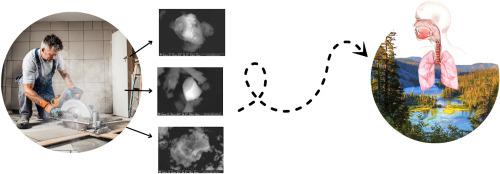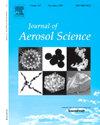Potential human exposure and risks of incidental nanoparticles released during rotary dry cutting of ceramic tiles
IF 3.9
3区 环境科学与生态学
Q2 ENGINEERING, CHEMICAL
引用次数: 0
Abstract
Rotary dry cutting and rectifying of ceramic tiles are sources of fine particulate matter (PM2.5) and nanoparticles (NPs). These activities are typically carried out inside industrial facilities during the manufacturing process, as well as outdoors and in residential indoor spaces during the installation phase, where mitigation measures are seldom implemented. This work aimed to understand the particle formation and release mechanisms, as well as particle properties (physical, chemical, and toxicological) and potential impacts on human health and the environment, for particles generated during ceramic tile rotary dry cutting operations. Aerosols were characterised in terms of particle number and mass concentrations, chemical composition, morphology and in vitro cytotoxicity. Two types of commercially available and representative tiles were tested in controlled chamber experiments: porous and non-porous ceramic body tiles (referred to in this work as A and B types, respectively). Results evidenced the release of fine particles and NPs during dry cutting of both materials, in comparable concentrations (20.000–45.000/cm3, 1-min average). However, the particle size distribution was significantly finer from A tiles (70% of the particle number concentration was nanosized (<100 nm)) in comparison to B tiles (<20%). While airborne particle chemical profiles were similar for both types of materials in the coarser size fractions (>0.6 μm), in the smaller size fractions (<0.6 μm) larger differences were observed. The chemical composition of airborne aerosols was consistent with that of the deposited dust. In vitro cytotoxicity responses evidenced statistically significant differences between exposure to aerosols from both types of tiles: cell viability was lower after exposure to aerosols from A tiles (50% at the original concentration) compared to those from B tiles, which exhibited high cell viability regardless of the aerosol concentration. Overall, results evidenced NP formation and release during rotary dry cutting of ceramic tiles, varying physical-chemical and cytotoxic profiles as a function of the material being processed, and highlight this activity as a potential health hazard in scenarios where prevention and mitigation measures are not implemented.

瓷砖旋转干切过程中附带释放的纳米颗粒对人体的潜在暴露和风险
瓷砖的旋转干切和整平是细颗粒物(PM2.5)和纳米颗粒物(NPs)的来源。这些活动通常在生产过程中在工业设施内进行,以及在安装阶段在室外和住宅室内空间进行,很少采取缓解措施。这项工作旨在了解瓷砖旋转干切割操作过程中产生的颗粒的形成和释放机制、颗粒特性(物理、化学和毒理学)以及对人类健康和环境的潜在影响。气溶胶的特征包括颗粒数量和质量浓度、化学成分、形态和体外细胞毒性。在控制室实验中测试了两种市售的具有代表性的瓷砖:多孔和无孔陶瓷砖(在本文中分别称为 A 型和 B 型)。结果表明,两种材料在干切过程中都释放出了细颗粒和 NPs,浓度相当(20.000-45.000/立方厘米,1 分钟平均值)。不过,与 B 型瓷砖(20%)相比,A 型瓷砖的粒度分布明显更细(70% 的颗粒数浓度为纳米级(100 纳米))。虽然两类材料在较粗粒径部分(0.6 微米)的空气传播颗粒化学成分情况相似,但在较小粒径部分(0.6 微米)却观察到了较大的差异。气载气溶胶的化学成分与沉积粉尘的化学成分一致。体外细胞毒性反应表明,暴露于两种类型瓷砖产生的气溶胶之间存在显著的统计学差异:暴露于 A 型瓷砖产生的气溶胶(原始浓度为 50%)后,细胞存活率低于暴露于 B 型瓷砖产生的气溶胶后,无论气溶胶浓度如何,细胞存活率都很高。总之,研究结果表明,在瓷砖旋转干切过程中会形成和释放 NP,不同的加工材料会产生不同的物理化学和细胞毒性特征,并强调在不采取预防和缓解措施的情况下,这种活动会对健康造成潜在危害。
本文章由计算机程序翻译,如有差异,请以英文原文为准。
求助全文
约1分钟内获得全文
求助全文
来源期刊

Journal of Aerosol Science
环境科学-工程:化工
CiteScore
8.80
自引率
8.90%
发文量
127
审稿时长
35 days
期刊介绍:
Founded in 1970, the Journal of Aerosol Science considers itself the prime vehicle for the publication of original work as well as reviews related to fundamental and applied aerosol research, as well as aerosol instrumentation. Its content is directed at scientists working in engineering disciplines, as well as physics, chemistry, and environmental sciences.
The editors welcome submissions of papers describing recent experimental, numerical, and theoretical research related to the following topics:
1. Fundamental Aerosol Science.
2. Applied Aerosol Science.
3. Instrumentation & Measurement Methods.
 求助内容:
求助内容: 应助结果提醒方式:
应助结果提醒方式:


